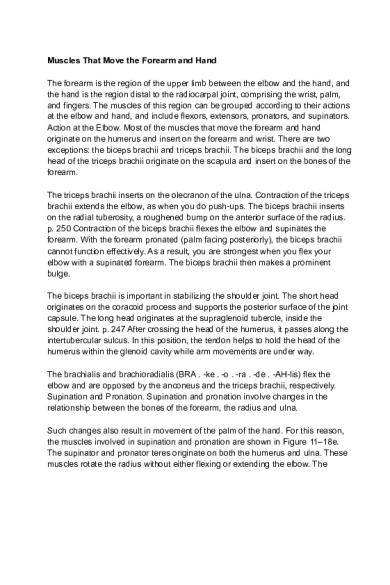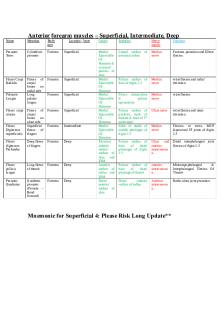Muscles That Move the Forearm and Hand PDF

| Title | Muscles That Move the Forearm and Hand |
|---|---|
| Course | Human Anatomy and Physiology with Lab I |
| Institution | The University of Texas at Dallas |
| Pages | 2 |
| File Size | 51.8 KB |
| File Type | |
| Total Downloads | 37 |
| Total Views | 142 |
Summary
Muscles That Move the Forearm and Hand...
Description
Muscles That Move the Forearm and Hand The forearm is the region of the upper limb between the elbow and the hand, and the hand is the region distal to the radiocarpal joint, comprising the wrist, palm, and fingers. The muscles of this region can be grouped according to their actions at the elbow and hand, and include flexors, extensors, pronators, and supinators. Action at the Elbow. Most of the muscles that move the forearm and hand originate on the humerus and insert on the forearm and wrist. There are two exceptions: the biceps brachii and triceps brachii. The biceps brachii and the long head of the triceps brachii originate on the scapula and insert on the bones of the forearm. The triceps brachii inserts on the olecranon of the ulna. Contraction of the triceps brachii extends the elbow, as when you do push-ups. The biceps brachii inserts on the radial tuberosity, a roughened bump on the anterior surface of the radius. p. 250 Contraction of the biceps brachii flexes the elbow and supinates the forearm. With the forearm pronated (palm facing posteriorly), the biceps brachii cannot function effectively. As a result, you are strongest when you flex your elbow with a supinated forearm. The biceps brachii then makes a prominent bulge. The biceps brachii is important in stabilizing the shoulder joint. The short head originates on the coracoid process and supports the posterior surface of the joint capsule. The long head originates at the supraglenoid tubercle, inside the shoulder joint. p. 247 After crossing the head of the humerus, it passes along the intertubercular sulcus. In this position, the tendon helps to hold the head of the humerus within the glenoid cavity while arm movements are under way. The brachialis and brachioradialis (BRA . -ke . -o . -ra . -de . -AH-lis) flex the elbow and are opposed by the anconeus and the triceps brachii, respectively. Supination and Pronation. Supination and pronation involve changes in the relationship between the bones of the forearm, the radius and ulna. Such changes also result in movement of the palm of the hand. For this reason, the muscles involved in supination and pronation are shown in Figure 11–18e. The supinator and pronator teres originate on both the humerus and ulna. These muscles rotate the radius without either flexing or extending the elbow. The
square-shaped pronator quadratus originates on the ulna and assists the pronator teres in opposing the actions of the supinator or biceps brachii. During pronation, the tendon of the biceps brachii rotates with the radius. As a result, this muscle cannot assist in flexion of the elbow when the forearm is pronated. Action at the Hand. The flexor carpi ulnaris, flexor carpi radialis, and palmaris longus are superficial muscles that work together to produce flexion of the wrist. The flexor carpi radialis flexes and abducts, and the flexor carpi ulnaris flexes and adducts. Pitcher’s arm is an inflammation at the origins of the flexor carpi muscles at the medial epicondyle of the humerus. This condition results from forcibly flexing the wrist just before releasing a baseball. The extensor carpi radialis and the extensor carpi ulnaris have a similar relationship to that between the flexor carpi muscles. That is, the extensor carpi radialis produces extension and abduction, whereas the extensor carpi ulnaris produces extension and adduction....
Similar Free PDFs

Muscles That Move the Leg
- 2 Pages

Posterior Forearm Muscles
- 2 Pages

Anterior forearm muscles
- 1 Pages

Lab 4 Elbow forearm hand
- 13 Pages

The Wrist and the Hand - Arthrology
- 11 Pages

The Wrist and the Hand - Arthrology
- 11 Pages

Origin and insertions of forearm
- 2 Pages

Muscles of the tongue
- 3 Pages

The Wrist and Hand - 25:10
- 5 Pages

THE Healthy HAND
- 156 Pages
Popular Institutions
- Tinajero National High School - Annex
- Politeknik Caltex Riau
- Yokohama City University
- SGT University
- University of Al-Qadisiyah
- Divine Word College of Vigan
- Techniek College Rotterdam
- Universidade de Santiago
- Universiti Teknologi MARA Cawangan Johor Kampus Pasir Gudang
- Poltekkes Kemenkes Yogyakarta
- Baguio City National High School
- Colegio san marcos
- preparatoria uno
- Centro de Bachillerato Tecnológico Industrial y de Servicios No. 107
- Dalian Maritime University
- Quang Trung Secondary School
- Colegio Tecnológico en Informática
- Corporación Regional de Educación Superior
- Grupo CEDVA
- Dar Al Uloom University
- Centro de Estudios Preuniversitarios de la Universidad Nacional de Ingeniería
- 上智大学
- Aakash International School, Nuna Majara
- San Felipe Neri Catholic School
- Kang Chiao International School - New Taipei City
- Misamis Occidental National High School
- Institución Educativa Escuela Normal Juan Ladrilleros
- Kolehiyo ng Pantukan
- Batanes State College
- Instituto Continental
- Sekolah Menengah Kejuruan Kesehatan Kaltara (Tarakan)
- Colegio de La Inmaculada Concepcion - Cebu





